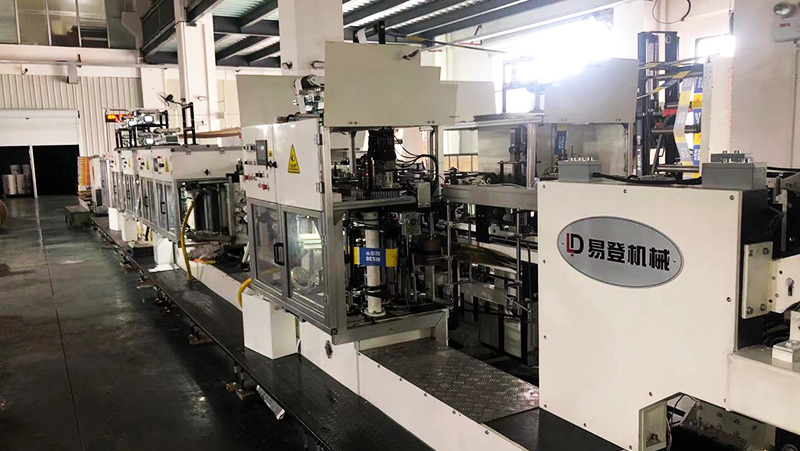Essential Practices for Effective Paper Bag Machine Maintenance
Release time:2025-05-23 Classification:Knowledge
Paper bag machines are critical assets in packaging operations, requiring consistent care to ensure productivity, safety, and product quality. Proper maintenance not only extends equipment lifespan but also minimizes downtime and operational costs. This article outlines proven strategies for optimizing paper bag machine performance through systematic maintenance practices.

1. Understanding the Importance of Routine Maintenance
Regular upkeep of paper bag machines prevents unexpected breakdowns and ensures seamless production. Components such as forming molds, sealing units, and conveyor belts undergo significant wear during operation. Neglecting maintenance can lead to misaligned seams, inconsistent bag dimensions, or even motor failures. By prioritizing preventive measures, operators reduce the risk of costly repairs and maintain output consistency.
2. Daily Maintenance Checklist
Implementing a daily inspection routine is foundational to machine reliability:
- Lubrication: Apply manufacturer-recommended lubricants to gears, bearings, and chains to minimize friction. Over-lubrication should be avoided to prevent debris buildup.
- Cleaning: Remove paper dust, adhesive residues, and loose particles from feeding systems, cutting blades, and folding mechanisms.
- Component Inspection: Check belts, rollers, and fasteners for wear or looseness. Tighten bolts and replace frayed belts promptly.
- Sensor Calibration: Verify the accuracy of photoelectric sensors and proximity switches to ensure precise bag positioning and folding.
3. Scheduled Preventive Maintenance
Beyond daily tasks, a structured preventive maintenance plan is vital:
- Weekly Tasks:
- Inspect electrical connections and wiring for corrosion or damage.
- Test emergency stop functions and safety interlocks.
- Clean air filters and ventilation systems to prevent overheating.
- Monthly Tasks:
- Examine hydraulic or pneumatic systems for leaks or pressure drops.
- Sharpen or replace dull cutting blades to maintain clean edges.
- Validate alignment of forming plates and gripper arms.
- Quarterly Tasks:
- Disassemble critical modules (e.g., glue applicators) for deep cleaning.
- Analyze motor performance and bearing conditions.
- Update software/firmware if the machine employs automated controls.
4. Troubleshooting Common Issues
Proactive troubleshooting resolves minor issues before they escalate:
- Uneven Sealing: Adjust temperature settings for heat sealers or inspect adhesive nozzle clogs.
- Jamming: Clear obstructions in the feeding path and verify paper tension settings.
- Misaligned Bags: Recalibrate folding mechanisms or check for worn guide rails.
Document recurring problems to identify patterns and refine maintenance protocols.
5. Operator Training and Safety
Well-trained personnel are integral to maintenance success. Operators should:
- Understand basic machine functions and error codes.
- Follow lockout/tagout procedures during repairs.
- Use PPE (gloves, goggles) when handling sharp components or adhesives.
Regular training refreshers ensure adherence to safety standards and operational best practices.
6. Spare Parts Management
Maintain an inventory of high-wear components:
- Cutting blades
- Drive belts
- Sensors
- Sealing elements
Label parts by machine model and prioritize OEM-compatible replacements to guarantee compatibility.
7. Long-Term Preservation Strategies
For machines in seasonal or intermittent use:
- Clean and lubricate all surfaces before storage.
- Cover the unit to shield it from dust and humidity.
- Run the machine briefly every 2–3 weeks to prevent component stiffening.
8. Leveraging Technology for Maintenance Efficiency
Modern paper bag machines often feature IoT-enabled diagnostics. Utilize these tools to:
- Monitor vibration levels and temperature trends.
- Schedule maintenance based on real-time performance data.
- Generate automated reports for compliance audits.
Effective paper bag machine maintenance demands a blend of diligence, technical knowledge, and foresight. By integrating daily inspections, preventive servicing, and operator education, facilities can achieve uninterrupted production cycles and maximize return on investment. Remember: A well-maintained machine isn’t just a cost-saving measure—it’s a cornerstone of sustainable packaging operations.
This guide provides actionable insights tailored to engineers and production managers, emphasizing practicality over theory. Adopt these practices to keep your paper bag machinery running at peak efficiency while upholding product quality standards.






